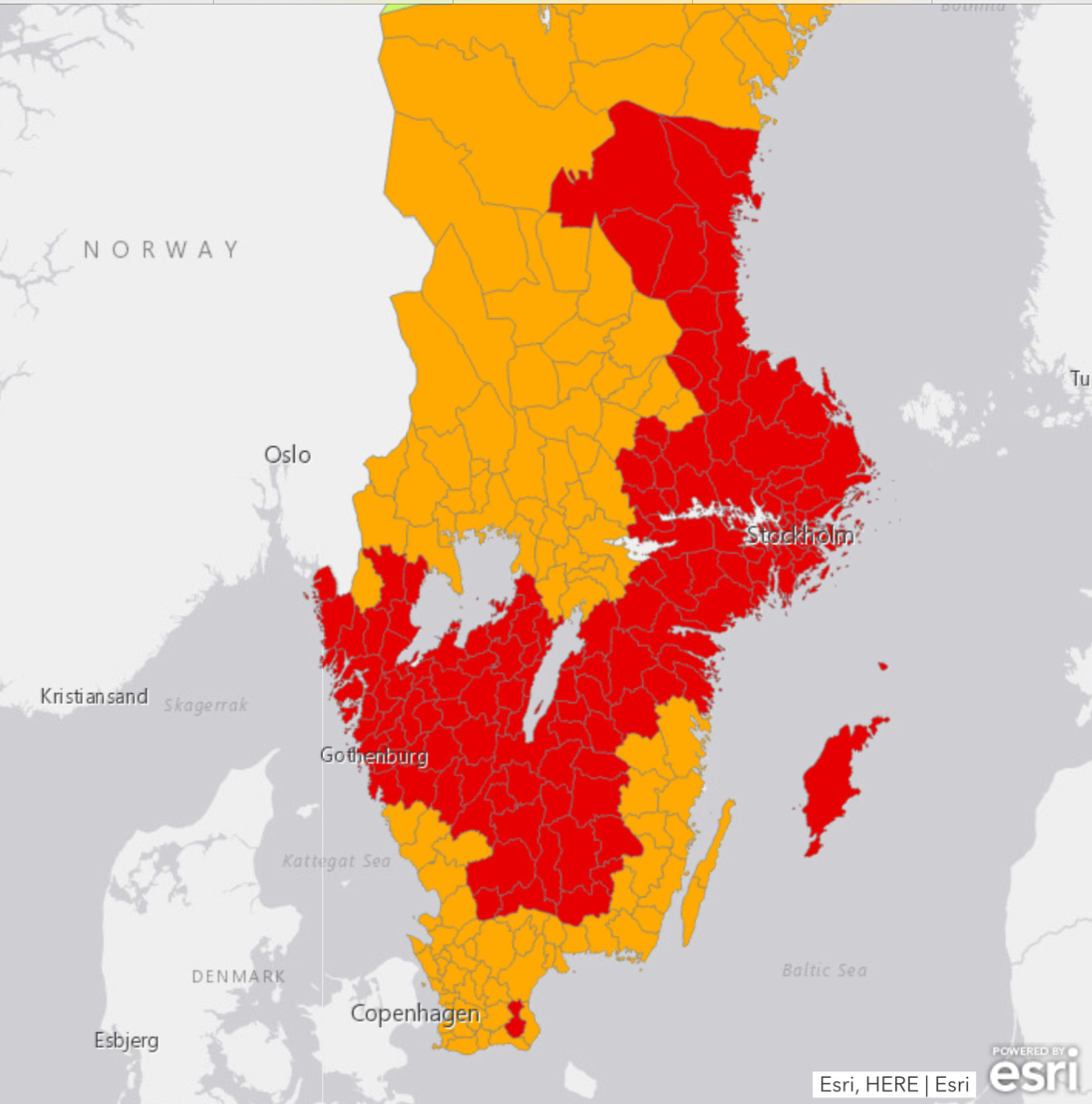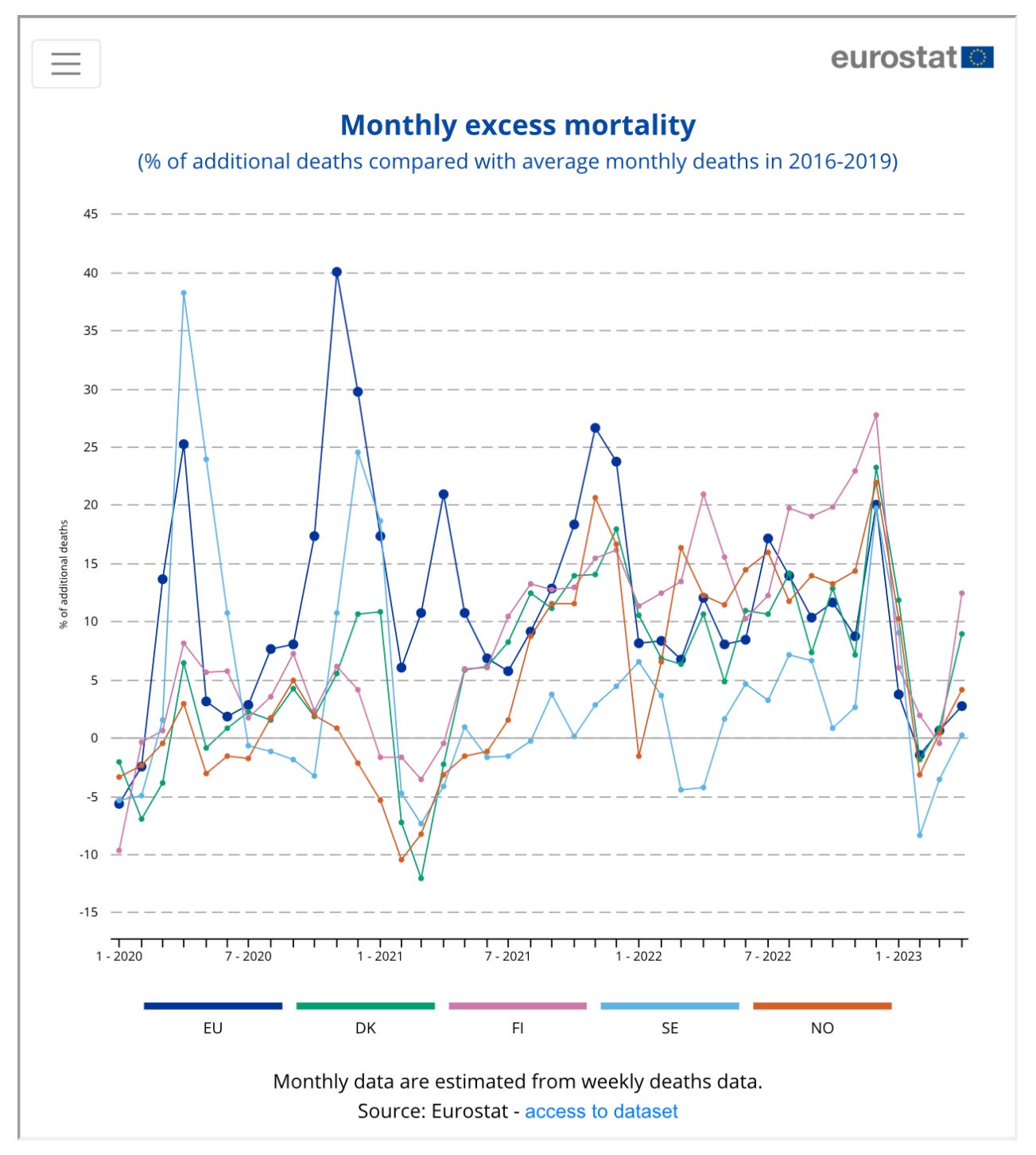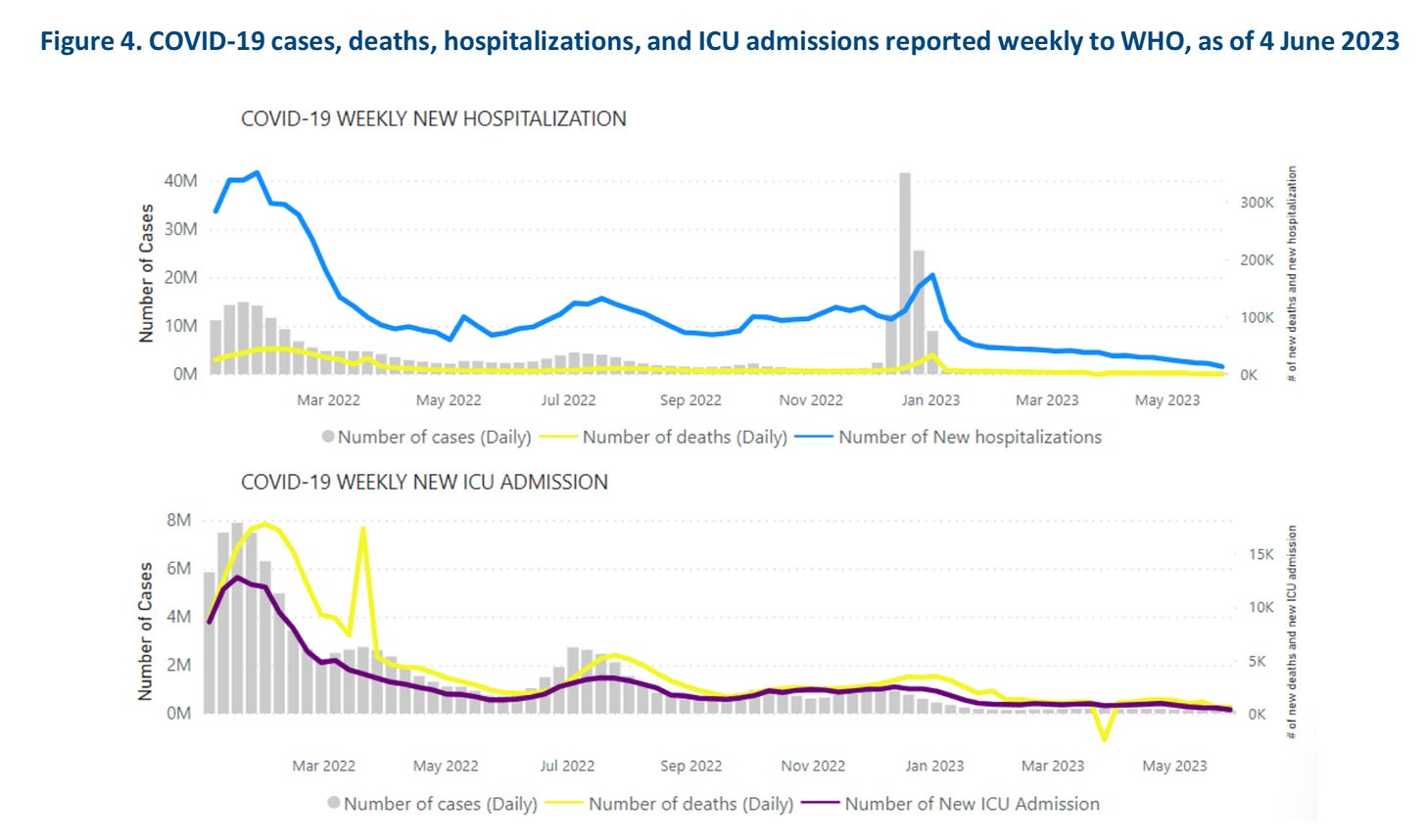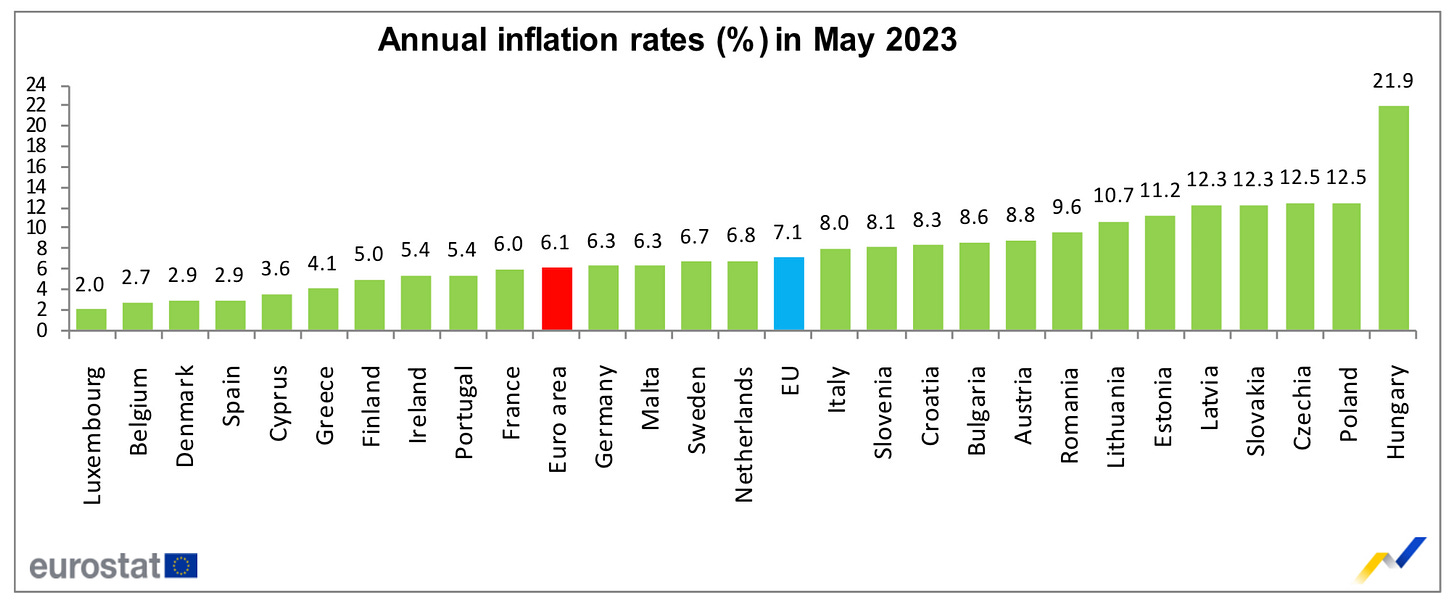☀️Drought☀️
🇩🇰
Some areas of Denmark finally had some rain and a lot of it. Cloudbursts over the weekend dropped a bucketload of rain in some areas in a very short period of time. For example, Slagelse recorded 19.4 millimeters of rainfall in just under half an hour on Saturday.
But while pockets of the country had some serious, albeit short, downpours the rainfall largely bypassed most of Denmark. And the rain didn’t fall long enough or in substantially large enough amounts to offset the ongoing drought. The Danish Meteorological Institute has reduced the drought index from the most severe 10 down to 9.8 nationwide.
Beginning tonight, DMI is forecasting more rain to arrive with one to five millimeters falling across most of the country. A second front could sweep up from Portugal and drop some more rain by Wednesday but there are no guarantees.
DMI Meteorologist Jesper Eriksen:
“It is far away from Denmark, so things can happen before it reaches us. It seems to be a bit more potent. We expect between 5-10 millimeters for most parts of the country, locally here and there maybe more.”
But while the rain is welcome news, Eriksen cautions that not enough rain will fall to derail the ongoing drought. Denmark would require a “nationwide rainstorm over several hours” to significantly reduce the drought.
-
Danish police in Southern Jutland have charged two more men for violating burning ban prohibitions. One was in Esbjerg where a man was fined for using a charcoal grill on his terrace. The other one, in Augustenborg, was charged for throwing a stack of papers on a campfire and then dousing them with lighter fluid.
Police also levied a 5,000 kroner fine (a shade under $1,000 Cdn) to a man for smoking a cigarette in a nature area on the island of Bornholm.
Police have also issued a number of warnings.
🇸🇪
The wildfire risk remains high to extremely high across nearly all of Sweden due to the hot weather and ongoing drought. The map below shows areas where there are currently wildfire bans. Orange for high-risk areas and red for extremely high-risk.
To see fire ban details in each Swedish region you can go HERE.
🦠Pandemic🦠
🇪🇺🦠
For a second straight month, excess mortality across the European Union has increased. According to the European statistics agency, EuroStat, excess mortality rose to +2.7% in April.
“This increase was more noticeable than in March 2023, when excess mortality was just slightly above the baseline at +0.6%.”
The agency notes that excess mortality rates in March and April have “returned to levels more in line with the rest of the COVID pandemic period.”
In April, 17 European countries recorded excess deaths. Among them, Austria (+13.2%), Finland (+12.4%), Luxembourg (+12.3%) and Ireland (+12.2%) recorded the highest excess mortality rates. Romania (-12.2%), Bulgaria (-8.7%), and Lithuania (-7.7%) recorded the lowest rates.
For context, excess mortality rates during the pandemic peaked in November of 2020 at +40%, or 140,000 more deaths than on average in any year before the pandemic.
In the chart below you can see how the Nordic countries stacked up in comparison to the European Union as a whole.
🇺🇸 💉
The formulation of this spring’s COVID booster dose was the big topic at last week’s U.S. Food and Drug Administration Committee meeting. The committee was presented with study findings and data on the protections of the previous variant-specific booster doses targeting the BA.4 and BA.5 strains. While it also got briefed on new formulations focusing on the XBB variants.
The committee was shown evidence that protections offered by BA.4/5 bivalent booster doses waned more rapidly against recombinant XBB infections.
It concluded that bivalent booster doses provide strong protection against severe infections resulting in hospitalization but there is evidence that protection is fading.
Interestingly, it found that the next generation of booster doses may be monovalent rather than bivalent. For most people, it has been more than a year since they had a monovalent vaccination. Because those protections may be waning there could be decreased defense against severe infections resulting in hospitalization. But people are still strongly shielded against being so sick they end up in intensive care or dead.
Included in the data was a randomized study of a new bivalent booster targeting the BA.5/XBB variants compared to an XBB.1.5 specific monovalent booster. The XBB.1.5 specific booster produced a strong antibody response and offered one possible avenue for the coming booster dose campaigns.
Another interesting finding was that COVID vaccination during pregnancy passed on protection against severe coronavirus cases requiring hospitalization. The protection was strongest in the first three months after birth but seemed to last for around six months.
Next, the FDA and CDC will continue to keep an eye on all the data and the changing COVID situation before tabling new recommendations for this fall’s booster dose formula.
🌎 🦠
Global COVID numbers continue to trend downward but so are testing and other infection surveillance. The World Health Organization says there were nearly 1.5 million new infections and another 7,300 lives lost to the virus in the 28-day period ending June 11.
“Reported cases are not an accurate representation of infection rates due to the reductions in testing and due to continued reductions in reporting globally. During this 28-day period, only 59%, 139 of 234 countries and territories reported cases, a proportion that has been consistently declining since mid-2022.”
Infection-related hospitalizations are also continuing to decline. There were 75,189 new admissions (-36%) and 2,015 new ICU patients (-41%) in the 28-day period ending June 4. The WHO notes that hospitalization data are subject to reporting delays.
Of the 22 countries regularly reporting hospital admissions data, four (18%) recorded hospitalization increases in excess of 20%. They are Bangladesh (+134%), Afghanistan (+109%), Zimbabwe (+100%), and Malta (+64%). Overall, the United States continues to see the highest number of new hospitalizations with 32,651 new admissions (-27%).
Just 16 countries have regularly reported intensive care admissions data. Of those, only one, Brunei (+20%), reported an increase of 20% or greater. France had the highest overall number of new ICU patients with 578 (-48%).
Both infection numbers and fatalities fell in all six global WHO regions.
Among the individual countries, South Korea remains a COVID hot spot with the most new reported infections of any country on earth with 475,577 (+14%) it was also one of the few countries that also saw fatalities increase (+14%). Australia continues to be a concern with 150,877 new coronavirus cases (+25%).
Brazil had the most coronavirus deaths with 1,175 deaths (-10%). It was followed by Russia with 516 lives lost (-41%) and Italy with 503 more fatalities (-26%).
Other hot spots around the world include Thailand where cases increased (+64%) and so did pandemic deaths (+417%), infections were up in Sri Lanka (+29%), Fiji (+3,500%), Cambodia (+930%), Spain (+40%), the Dominican Republic (+247%), the U.S. Virgin Islands (+96%) and Zambia (+454%). Greece did not see infections rise and they didn’t decline either with 50,883 new cases, which is pretty similar to what it saw in the previous 28-day reporting period.
There were a mere 15,789 sequenced positive test results submitted to the global genome database over a 28-day span. The WHO says that based on this severely limited pool of data it looks like XBB.1.5 remains dominant around the world it is continuing to lose ground to the quickly rising XBB.1.16 variant.
-
World Health Organization member nations met this week to continue efforts to hash out a new global pandemic prevention, preparedness, and response agreement. The goal is to table a draft accord by May of next year.
Intergovernmental Negotiating Body Bureau Co-Chair Precious Matsoso of South Africa:
“There was an excellent spirit of collaboration amongst the countries’ representatives. When there are 194 countries sharing their views, it will, of course, take time and much discussion to come to an agreement on the many important issues concerning pandemic prevention, preparedness, and response. I am confident that we now have the working arrangements in place to do so.”
🇪🇺🦠
The European COVID situation remains stable, from what the European Centre for Disease Prevention and Control can tell with shrinking pools of surveillance data.
There were 288 COVID deaths across the 21 European countries reporting fatality data. That is 48 fewer lives lost than in the week previous. Just one country, Latvia, registered an upward trend in coronavirus deaths.
In the week ending June 11, Spain, Norway, and Croatia didn’t report any coronavirus information.
Just one country reported an increase in coronavirus activity specifically among seniors over 80. Other than that there wasn’t a single increasing case trend of any of the countries reporting data across the EU and the greater European Economic Area. There were also no countries reporting any increases in hospitalization numbers.
Uptake for a 2nd booster dose remains embarrassingly low across Europe with just 35.6% of vulnerable seniors availing themselves of the protection the variant-specific booster doses provide.
A mere ten countries were meeting the bare minimum requirement of reporting 10 sequenced positive test results over a two-week period. Based on that exceedingly narrow window it looks like XBB.1.5 remains the dominant strain in Europe.
🇸🇪
Swedish healthcare continues to see waiting lists for treatment grow longer and longer. The National Audit Office says political measures and other attempts to reduce waiting times have all failed. In 2010, Sweden legislated that people must receive care within 90 days. But just over 40% of people needing a variety of procedures end up on waiting lists for longer than the mandatory 90-day period.
While the problem pre-dated the pandemic, three years of battling the coronavirus did nothing but add to existing waiting time woes. This is on top of contributing to other exacerbating factors like healthcare workers burning out and leaving the job.
With billions of Swedish kroner already thrown at the problem over the years, the National Audit Office says more initiatives are needed that get results and offer better value for money spent.
🇩🇰
The Danish healthcare system is dealing with its own pandemic hangover with significant efforts being made to seriously reduce growing wait lists. Years of postponed or delayed procedures during the pandemic were compounded by last years’ nurses’ strike. This is being exacerbated by a shortage of doctors. Now as efforts are being made to get Denmark’s healthcare system back on track there is an effort underway to lure doctors from Sweden.
After completing their medical studies doctors must complete a one-year basic training program working in hospitals and in general practice. In Sweden, there is a waiting list for the basic training program. But not so much in Denmark. Add in a stronger Danish kroner and a 37-hour work week compared to 45 in Sweden and suddenly Denmark becomes a very attractive place for Swedish doctors to begin their careers.
Hospitals in Slagelse, Næstved, and Ringsted have all launched efforts to recruit Swedish healthcare workers. And others are beginning to follow suit. Already 28 Swedes are working in the three hospitals.
Swedish doctors looking to come to Denmark for clinical training are screened for their Danish language skills and whether there is an attachment to Denmark so that they might stay.
-
Sickness absences among municipal employees in Denmark continued to climb last year. As you might expect the rates of calling in sick have been increasing since the COVID pandemic arrived in 2020. An average of 7.1% of municipal workers called in sick last year according to a report by the National Welfare Research and Analysis Center for Welfare.
Researchers point the finger at the coronavirus, soaring influenza cases, the return of other diseases, and possibly record-high employment rates. The theory is that with so many people finding jobs that there is an increase in the number of workers with health challenges who are working in municipalities.
⚡Energy & Environment🍃
🇪🇺
Inflation continues to ease across Europe in May. Inflation fell from 7% to 6.1% across the Euro zone. Specifically, within the European Union inflation also dipped to 7.1%, down from the previous month’s 8.1%.
European statistical agency, EuroStat, says the lowest inflation rates were seen in Luxembourg (2%), Belgium (2.7%), Denmark, and Spain (both 2.9%). While Hungary (21.9%), Poland, and the Czech Republic (both 12.5%) had the highest rates of inflation.
Month-to-month inflation fell in 26 countries and rose in one.
Food, alcohol, and tobacco continue to be an inflation driver (+2.54%), as are services (+2.15%), and non-energy industrial goods (+1.51%).
🇩🇰
While Denmark has been battling a severe drought due to scorching temperatures there is a silver, or rather green, lining. Over the last week or solar and wind energy have produced enough power to cover over 85% of the country’s energy needs. Green energy production even hit 102.1% recently, pumping more clean energy into the grid than could be used.
Green Power Denmark Chief Consultant Kristian Rune Poulsen says the energy transition is in full swing and it is going to require us to rethink how we do things.
“This is the solution to the energy crisis. And it is here to stay. We can adjust accordingly. We don't always have to charge the electric car at night, in the summer we have to use electricity in the middle of the day. The same applies to companies.”
🇫🇮 🇳🇴 🇸🇪
The electric vehicle revolution is on in Finland. The Automotive Information Centre is forecasting that with current sales trends EVs will account for almost 70% of all registered cars on the road by 2050.
While vehicle consumers are being more and more won over by electric cars, the high sticker price and long waiting lists remain major roadblocks. As of the beginning of June, there were 175,000 hybrid or fully electric vehicles rolling around Finland.
However, Finland remains well behind its Nordic neighbours. Fully electric and hybrid vehicles account for about 62% of all new car sales in Sweden. While Norway remains the Scandinavian EV king. Almost 89% of all new vehicle sales in Norway just last month were either fully electric or hybrid. About half of all cars on the road in Norway are either hybrid or fully electric.
🇪🇸
The drought in Spain has claimed a popular tourism destination. The Fuente de Piedra wetlands north of Malaga are usually home to thousands of flamingos and a favorite stop for hundreds of thousands of tourists who flock to see them. But the searing heat and grinding drought have largely dried up the large seawater lagoon the birds call home. This has led to a dramatic decline in the number of flamingos with just a few still remaining.
Alberto Gonzalez Sanchez lives in the area and spoke to Reuters:
“It's a shame in terms of tourism, people come here on day trips. Usually, the lagoon is filled with flamingos and many other birds. It seems that climate change is to blame for this.”
According to Andalusia’s Ministry of Agriculture, Livestock, Fisheries and Sustainability, more than 200,000 flamingo chicks have been born in the wetlands since 1984.
Spain is experiencing its hottest spring ever recorded. It is also the second driest since the country began keeping track back in 1961.
🇨🇭
In a referendum voters in Switzerland have approved a new climate law that mandates the country phase out the use of fossil fuels by 2050, the same year Switzerland has pledged to reach zero emissions. The measure passed with 59% support.
🇺🇦/ 🇷🇺 War
🇩🇰 🇺🇦
Denmark has moved a step closer to possibly donating F-16 fighter jets to Ukraine. Acting Minister of Defense Troels Lund Poulsen said after the summer holidays the government will begin discussions on whether or not to donate its aging F-16s to Ukraine. Denmark is one of a coalition of European countries committing to training Ukrainian pilots on F-16s.
Poulsen spoke to DR:
“I don't rule it out. When we give them the tools to enable them to fly F-16 aircraft, we must also discuss whether we will have to donate the fighter jets.”
But Poulsen added this is not a decision that Denmark can make unilaterally as it must be made with its allies. It must also have the blessing of the United States which has the final say on whether F-16s can be exported from one country to another.
🇸🇪 🇺🇦
The Swedish government has agreed to provide training for Ukrainian pilots on the Swedish-made JAS-39 Gripen fighter jets. Ukraine had requested an “operational evaluation” of getting pilots up to speed on the aircraft. While Ukraine has primarily been focused on modernizing its Air Force with F-16 fighter jets other aircraft are obviously being considered.
To date, no country has offered to donate F-16 fighter jets, or in Sweden’s case the Gripen warplanes, to Ukraine.
NATO 🇩🇰
NATO is turning its attention to protecting valuable undersea infrastructure. Hundreds of kilometers of gas, oil, electricity, and internet cables and pipes run along the seabed in the Baltic, North, and Norwegian seas. NATO defense ministers have established a new centre for the safety of critical underwater infrastructure. While it is impossible to keep tabs on every inch of the massive network of pipes, cables, and wires on the sea floor the hope is that NATO can better assess any threats and act on them quickly.
NATO Secretary-General Jens Stoltenberg:
“Of course, we cannot have a NATO presence along all the thousands of kilometers of critical infrastructure underwater, but we can get better at gathering information, intelligence, sharing information and connecting the dots. By collecting that information, we can more easily see when something abnormal is happening and act on it.”
Acting Danish Defense Minister Troels Lund Poulsen spoke to DR to say the sabotage of the Nord Stream pipelines is a perfect example of the potential threat.
“Among other things, it comes on the basis of the incident we saw in 2022 in the Baltic Sea around the Nord Stream, but for that matter also some of the other things we are experiencing at the moment. Unfortunately, we are now living in a new security situation, where the threats have become completely different, and Russia has decided, and they will now have parts of our critical infrastructure mapped to a much greater extent, and we must do what we can to protect ourselves.”
A recent collaborative investigation between the public broadcasters of Denmark, Sweden, Norway, and Finland found that Russian ships posing as fishing vessels and freighters may have been secretly mapping critical undersea infrastructure.
🇸🇪 🇺🇸 🇹🇷
The U.S. Ambassador to Turkey appears to have killed any lingering hope that Sweden might become a member of NATO by this summer. Jeff Flake says it isn’t the news that Sweden wants to hear but he does not believe that Turkey will stop its opposition before the summit in July.
Flake spoke to Axios:
“It seems unlikely that we will see any development before Vilnius. [This is] a bit disappointing for the Swedes, I think. They feel they have taken the measures that they were asked to take and then some.”
But, Flake does think having all the NATO member nations in Lithuania together should provide an opportunity for more talks and potentially some positive developments.
NATO
The top job at NATO is still up for grabs. There were reports that U.S. President Joe Biden asked current Secretary-General Jens Stoltenberg to stay in office for at least one more year. For his part, Stoltenberg said publicly he has no plans to remain in the position.
“I have no other plans than to end my work here when my current mandate expires. I have been saying that for some time now.”
This seems to indicate that a suitable replacement still hasn’t been found. Stoltenberg’s term ends this October.
🇸🇪 🇺🇦/ 🇷🇺
IKEA is boycotting Mondelez food products after Ukraine labeled the company a “war sponsor” last month due to it continuing to do business with Russia. Mondelez is the company behind brand names like Marabou, Daim, O'boy Cocoa, Oreo, and Philadelphia cream cheese. The iconic Swedish furniture giant IKEA is the latest to jump on a growing boycott of the company’s products. Swedish amusement parks and even cities like Gothenburg have all turfed Mondelez products.
Swedish Finance Minister Elisabeth Svantesson spoke to news agency TT:
“It is important to know what you're supporting when buying certain goods. Now we have received information that this may benefit Russia's war chest.”








